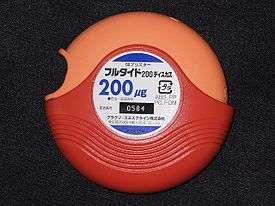Dry-powder inhaler

A dry-powder inhaler (DPI) is a device that delivers medication to the lungs in the form of a dry powder. DPIs are commonly used to treat respiratory diseases such as asthma, bronchitis, emphysema and COPD although DPIs (such as inhalable insulin Afrezza) have also been used in the treatment of diabetes mellitus.[1]
DPIs are an alternative to the aerosol-based inhalers commonly called metered-dose inhaler (or MDI). The DPIs may require some procedure to allow a measured dose of powder to be ready for the patient to take. The medication is commonly held either in a capsule for manual loading or a proprietary from inside the inhaler. Once loaded or actuated, the operator puts the mouthpiece of the inhaler into their mouth and takes a sharp, deep inhalation (ensuring that the medication reaches the lower parts of the lungs), holding their breath for 5–10 seconds. There are a variety of such devices. The dose that can be delivered is typically less than a few tens of milligrams in a single breath since larger powder doses may lead to provocation of cough.
Most DPIs rely on the force of patient inhalation to entrain powder from the device and subsequently break-up the powder into particles that are small enough to reach the lungs.[2] For this reason, insufficient patient inhalation flow rates may lead to reduced dose delivery and incomplete deaggregation of the powder, leading to unsatisfactory device performance. Thus, most DPIs have a minimum inspiratory effort that is needed for proper use and it is for this reason that such DPIs are normally used only in older children and adults.
Lactose
Some powder inhalers use lactose to:
- Carry the fine particles of the active component (which must be fine to reach its target)
- Improve the flow-ability of the powder during manufacturing and help handling
- Act as a bulking agent
- Aid in powder uptake from the device during inhalation and aerosolization
It has been suggested that such lactose may be harmful to lactose intolerant people,[3] and some doctors advise patients not to use lactose containing DPIs[4] to minimize the risk of hypersensitivity reactions.[5]
Storage
DPI medication must be stored in a dry place in a temperature of not more than 25 °C (77 °F) and humidity between 40–50% in a sealed packaging, since exposure of the powder to moisture degrades the ability of the device to disperse its medication as a fine powder upon inhalation. Some medication also needs photo protection.
See also
References
- ↑ "Exubera Prescribing Information" (PDF). FDA.gov. Pfizer. April 2008. Archived from the original (PDF) on January 18, 2009. Retrieved 2009-02-27.
- ↑ Finlay, Warren H. (2001). The mechanics of inhaled pharmaceutical aerosols: an introduction. Boston: Academic Press. ISBN 0-12-256971-7.
- ↑ Changes in Inhaler Devices for Asthma And COPD - Health - RedOrbit
- ↑ Milk Proteins and Allergy Medications
- ↑ Hypersensitivity Reaction After Inhalation of a Lactose-Containing Dry Powder Inhaler
Further reading
- Guidance for Industry: Metered Dose Inhaler (MDI) and Dry Powder Inhaler (DPI) Drug Products – Food and Drug Administration Center for Drug Evaluation and Research (CDER)
- The Diskus(tm) Inhaler – Medscape Today clinical drug investigation
-solution.jpg)


